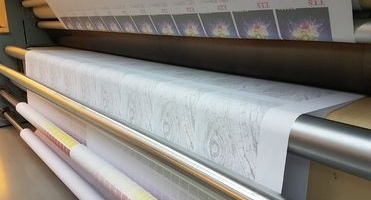
TTS notices that more and more printer manufacturers are departing from the direction they took several years ago. At that time, they decided to develop only 320-cm machines for the direct printing of textiles for visual communication (soft sign). Now they are reverting to machines that are suitable for sublimation transfer paper. This medium and the machines have been developed to such an extent in recent years that the benefits of printing with transfer paper overshadow those of direct printing. TTS is completely prepared for this development, and is introducing a number of new and suitable papers that have been tested on these fast, new, 320-cm wide transfer printers.
The advantages of transfer printing
Over recent years, direct printing was sold as the best solution for printing textiles for visual communication, such as banners for event decoration, textiles for stand building, and textiles for retail and office decoration. This was because sublimation transfer printing was expensive and complicated, especially at 320 cm wide. The price of transfer paper has now fallen, and knowledge and experience of its use has increased. As a result, companies can see that transfer printing is a better solution than direct printing. Because the coating on the paper ensures that the ink dries, eliminating the need for pre-treatment of the textile, the textile is much less likely to crease and has a softer hand. The colours are even more vivid, and there is no risk of the ink rubbing off – something especially important with upholstery materials. Also, the problem encountered with direct printing, that the ink runs with outdoor use (because ink residues remain in the textile after fixing), does not occur with transfer printing.
New machines make transfer printing interesting again
Since the start of 2017, we have seen various (major) printer manufacturers – Durst, EFI/Reggiani, Mimaki and MS-print – bringing out 320-cm wide machines for transfer paper. Previously, the paper did not always run well through transfer printers of this width, making it necessary to use heavier, more expensive paper. This made transfer printing less interesting. The new machines make it possible to use lighter paper, which is less expensive. In addition, transfer printing is interesting again for printers because:• Transfer printing uses 20 to 30% less ink and there are no additional costs;
• Printing is always done on the same medium (the transfer paper), so you don't have to create a new profile each time for each piece of textile;
• The printer stays cleaner than with direct printing on textile. This means less maintenance, and reduced frequency of cleaning;
• The pre-treatment of the textiles no longer determines the print quality. This gives the printer more flexibility in switching between textile suppliers;
• You can print on a much broader range of textiles, such as non-wovens, event carpet, stretch textiles, etc.;
• The material is less sensitive to creasing, which is especially important with textiles for light boxes. With a back-lit textile, every small crease is visible because it is illuminated from behind. Because the textile is no longer pre-treated for direct printing, it creases much less and the result is taut and professional-looking;
• A printer fault (nozzle failure) is much less costly than when direct printing is used: if something goes wrong and goes unnoticed – because the printing is done unattended – such an error only affects paper worth just € 0.30 to € 0.50 per m2 instead of a roll of textile costing € 2.00 to € 5.00 per m2.
Freedom of choice and new markets
With transfer printing, the customer has more freedom of choice in textiles. Textiles for transfer are general softer and are therefore less sensitive to showing fold lines or creases compared to textiles pre-treated for direct printing. This makes it a better option when you have to send something folded, which is one of the main selling points for textiles compared to paper posters or PVC. Furthermore, there is now the possibility to print textiles for interior use (curtains, furniture) or fashion; these are two markets currently not often served by sign printers. This means a major opportunity for expanding your customer portfolio!
TTS introduces new transfer papers for new printers
TTS ready to seize these opportunities together with its customers. We are introducing a number of new papers that are suitable for the fast, new transfer printers and have been tested on them. For example, SX20HS-EC, SX30EC and SX10X. We also offer a wide range of textiles for visual communication and interior applications; these are specifically for the transfer technique, so do not have the pre-treatment for direct printing. These textiles are softer and have a softer hand. Furthermore, we offer a variety of non-woven materials, which are perfect for economic, eco-friendly event banners (but only for transfer). Our assortment also includes event carpets (which are only for transfer printing).